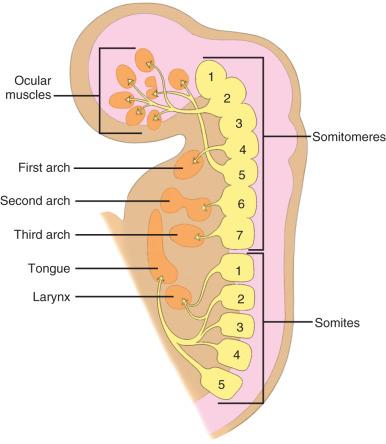Physical Address
304 North Cardinal St.
Dorchester Center, MA 02124
Accurate diagnosis and successful treatment of congenital anomalies and masses of the neck are dependent on an understanding of the complex embryologic development of this region and the anomalies that result from abnormal development.
This chapter will focus on the embryology of the neck and the oral cavity. The embryology of the orbit, face and sinuses, temporal bone, and ear are addressed in Chapter 4, Chapter 8, Chapter 9, Chapter 18 .
Many of the structures of the head and neck form from an interaction between somitomeres, somites, the mesenchyme, and the branchial apparatus.
The mesenchyme is derived from three main sources:
The lateral plate mesoderm, which forms the laryngeal cartilages and regional connective tissue
The neural crest cells, whose migration initiates the formation of the pharyngeal arch skeletal structures and regional bone, cartilage, tendons, and glandular stroma
The ectodermal placodes, from which originate the fifth, seventh, ninth, and tenth cranial nerves (CNs)
After neurulation occurs, the mesoderm subdivides into the lateral, intermediate, and paraxial mesoderm. The lateral mesoderm forms most of the throat and larynx. The intermediate mesoderm does not form any part of the head and neck. The paraxial mesoderm forms the 7 somitomeres and 42 to 44 paired somites. The five most rostral somites are involved in the formation of head and neck musculature ( Fig. 13.1 ). The somitomeres and somites form before the development of the branchial apparatus.

The branchial apparatus, that is, the branchial arches, clefts, pouches, and membrane, begin to form late in the third week of gestation. The buccopharyngeal membrane breaks down, and the mesodermal branchial bars begin to form six pairs of branchial arches. The fifth arch is rudimentary and disappears.
The fourth somitomere invades the first branchial arch and generates the formation of the muscles of mastication, that is, the masseter, pterygoid, and temporalis muscles. These muscles are innervated by the trigeminal nerve (CN V).
The seventh somitomere interacts with the third brachial arch to form the stylopharyngeus muscle, which is innervated by the glossopharyngeal nerve (CN IX).
The first four occipital somites invade the fourth and sixth brachial arches and thus stimulate the formation of the extrinsic and intrinsic laryngeal muscles innervated by the vagus nerve (CN X) and the cranial segment of the spinal accessory nerve (CN XI).
The third through seventh somites form the sternocleidomastoid muscle and trapezius and are innervated by the spinal accessory nerve (CN XI).
The intrinsic and extrinsic tongue muscles are likely derived from the second through fourth occipital somites and are innervated by the hypoglossal nerve (CN XII).
The contribution of the somitomeres and somites to the formation of muscles and their distinct innervation is unchanged throughout growth and development. Thus although many muscles migrate in location, their nerve supply is maintained and hence their branchial arch origin can always be identified (see Fig. 13.1 ).
Formation of the branchial apparatus occurs between the fourth through seventh weeks of development. The pharynx constitutes much of the foregut during the first few weeks of development. Formation of the five branchial arches (I, II, III, IV, and VI) results from the breakdown of the buccopharyngeal membrane and segmentation of the mesoderm. Migration of neural crest cells to this location stimulates growth and development. Each arch has its own outer epithelial lining of ectoderm separated by five clefts and an inner epithelial lining of endoderm with five corresponding pouches and a central cartilaginous core, which is a mesenchymal derivative that participates in the formation of the characteristic skeletal, muscular, ligamentous, vascular, and neural components of each arch.
Shortly after formation of the branchial arches, the first and second arches undergo mesodermal proliferation, thus creating the epicardial ridge, which contains the mesodermal precursor of the sternocleidomastoid, the trapezius, and the infrahyoid and lingual muscles. The nerves of the epicardial ridge are the hypoglossal (CN XII) and spinal accessory (CN XI) nerves. The proliferation of mesenchyme overgrows branchial arches II, III, and IV and narrows branchial clefts II, III, and IV. Subsequently, an ectodermal pit is formed—the cervical sinus of His—which obliterates with further development; failure of obliteration results in formation of branchial sinus, clefts, or cysts of types II, III, or IV.
Become a Clinical Tree membership for Full access and enjoy Unlimited articles
If you are a member. Log in here